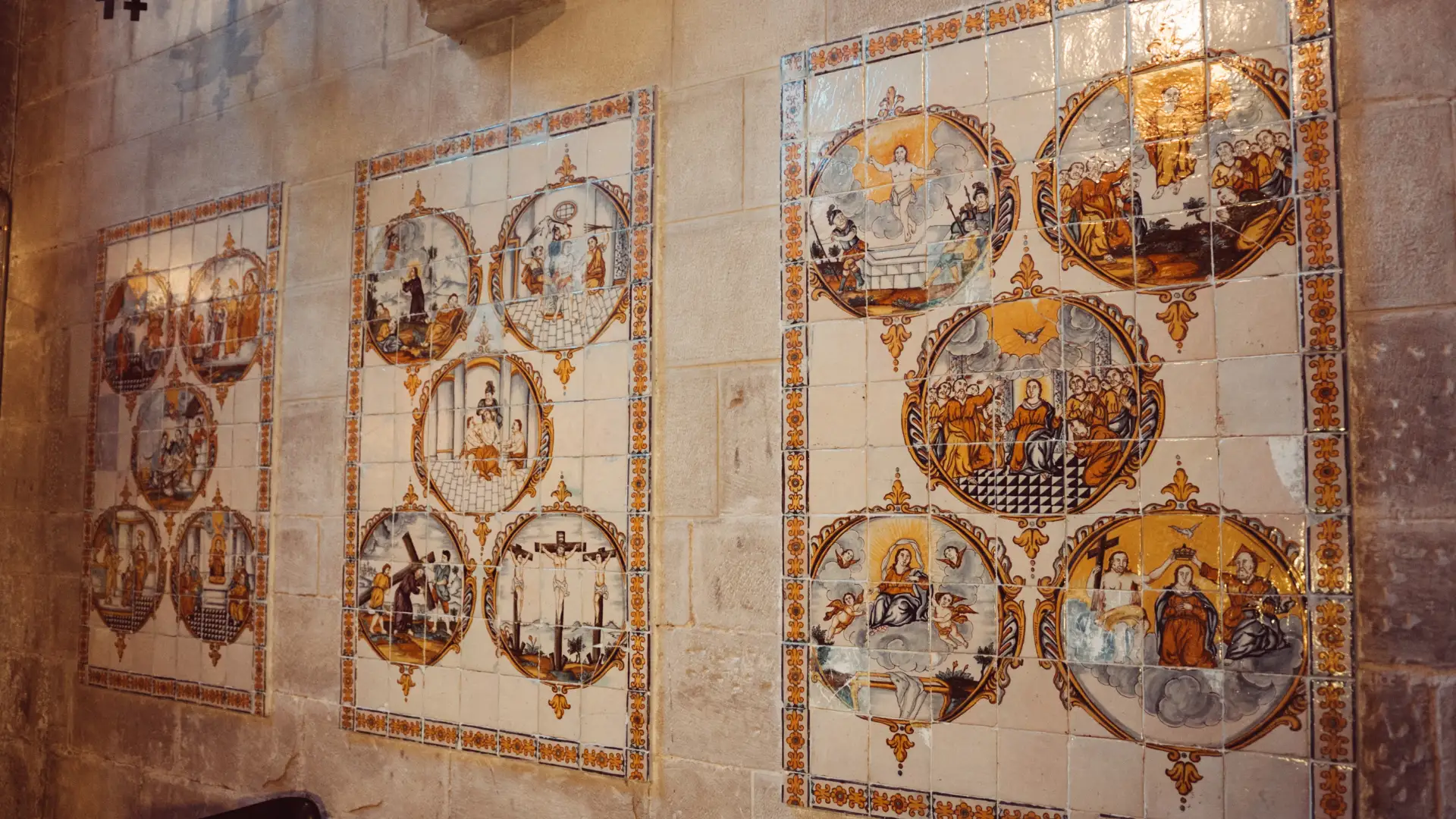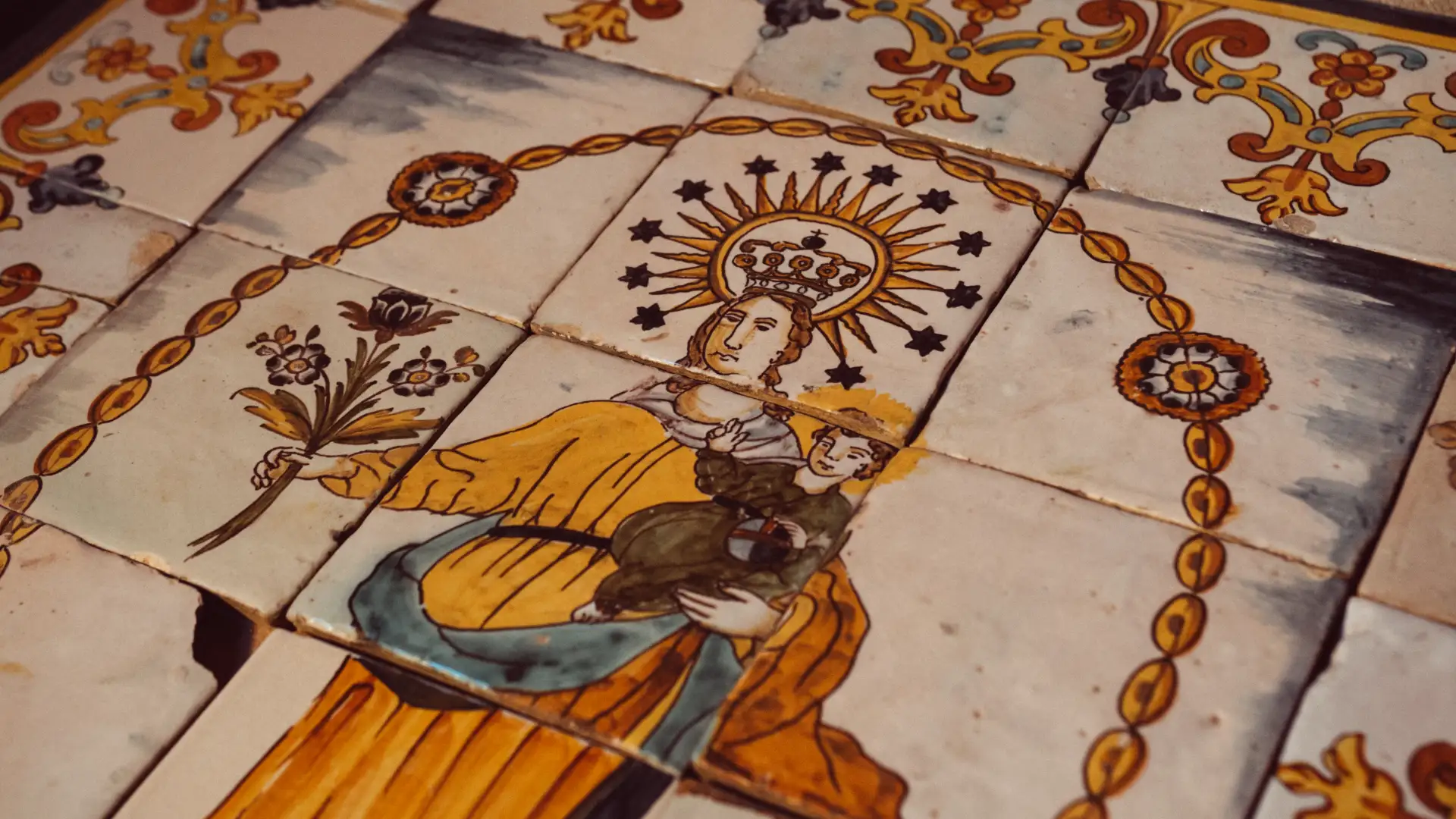
Els Misteris del Rosari

Description
Topic: Religious.
Elements: Capella del Roser presided over by the titular image of the altarpiece of the same invocation. In the lower part there are three panels of tiles with the fifteen mysteries of the Rose, probably from the 18th century, from the year 1980. In 2024 the image of the Virgin Mary was placed del Roser, in tiles and surrounded by a Rosary that accompanies the panels. The Mysteries of the Rosary tiles form three panels that show us the fifteen mysteries of the Rosary; of joy, of pain and of glory. Each panel is composed of seventy-seven tiles, in seven columns of eleven horizontal rows. In addition, the outline is surrounded by an outer border that measures 13 x 6 centimeters. The panels reproduce the theme of the Mysteries of the Rosary which was reproduced on numerous occasions, with a very similar iconography in most cases; the outline of the faces, the composition of the clouds, and above all the use of the yellow color that makes it characteristic.
Style: Figurative
Symbolism: The Rosary is a form of Marian devotion that consists of the recitation of fifteen dozen Hail Marys, the Lord’s Prayer and the Glory Be. The recitation helped to meditate on the Mysteries of Joy, Pain and Glory, linked to the lives of Mary and Jesus.
Mysteries of Joy
- The Incarnation of the Son of God in the Most Pure womb of the Virgin Mary
- Visitation of the Virgin Mary to her cousin Santa Isabel
- Birth of the Son of God at the Gate of Bethlehem
- The Purification of the Virgin Mary and the presentation of the Infant Jesus in the temple
- The Lost and Found Child in the Temple.
Mysteries of Pain
- Prayer of Jesus in the garden of Gethsemani
- The flagellation of the Lord on the column
- The Crowning of Thorns
- The Viacrucis, way of Calvary with the Cross around the neck
- The Crucifixion and death of the Lord
Mysteries of Glory
- The Resurrection of the Lord
- The ascension of the Lord
- The coming of the Holy Spirit on the apostles and Mary Santíssima
- The Assumption of the Virgin in body and soul into Heaven
- The Coronation of the Virgin Mary as Queen and Mistress of Heaven and Earth, Mother and Advocate of sinners.
Context
Ordered: Unknown.
Historical context: We know that the current placement in the chapel of the Rose is not the original, during the Civil War they were removed and later, in 1980, they were placed where they are now. As a result of a recent publication which analyzes the shield makers’ workshops that were active during the 15th-19th centuries, by Antoni Cerdà Mellado, we find the author of the Mysteries of the Rosary tile panels. According to Cerdà, the representation of the mysteries would correspond to Bernat Reig Foraster, corresponding to a lineage originally from the Albi, who went to Barcelona and came to have three workshops. It seems that the Reigs came to dominate Barcelona’s shield production, with more than twenty shield makers with the surname Reig. The theme of the Mysteries of the Rosary was reproduced on numerous occasions by this workshop, with a very similar iconography in most cases; the outline of the faces, the composition of the clouds, and above all the use of the yellow color that makes it characteristic. This series of medallions with the Mysteries of the Rosary should be very popular, given that they are preserved in different public and private collections. The reason why Verdú’s representation is particularly relevant is that the entire series is preserved here, which is very unusual. Cerdà dates the tiles to the end of the 18th century, around 1790. The Reig workshop had commissions for the Casa de la Convalescència, current headquarters of the IEC and Library of Catalonia, the Monastery of les Avellanes, Arenys de Mar, Manresa and also some tiles preserved in the Vicenç Ros Museum in Martorell. The production of the Reig workshop does not stop here, but we know that it also shipped tiles to Havana, Puerto Rico, Cartagena de Indias and Buenos Aires.

Map: Els Misteris del Rosari
How to do the route?
The Verdú Ceramic Murals Route is designed so that you can do it at your leisure. Stroll through the village streets and discover each mural at your own pace, enjoying the art and history surrounding our black pottery.
Come to Verdú and live a unique and unforgettable experience!
Do you know how to get to Verdú?
Verdú is located in the Urgell region, in the province of Lleida, Catalonia.
To get there, you can take the A-2 motorway to Tàrrega and then follow the C-14 road to Verdú. You can also reach Tàrrega by train. From Tàrrega to Verdú travel must be done by taxi or on foot.
